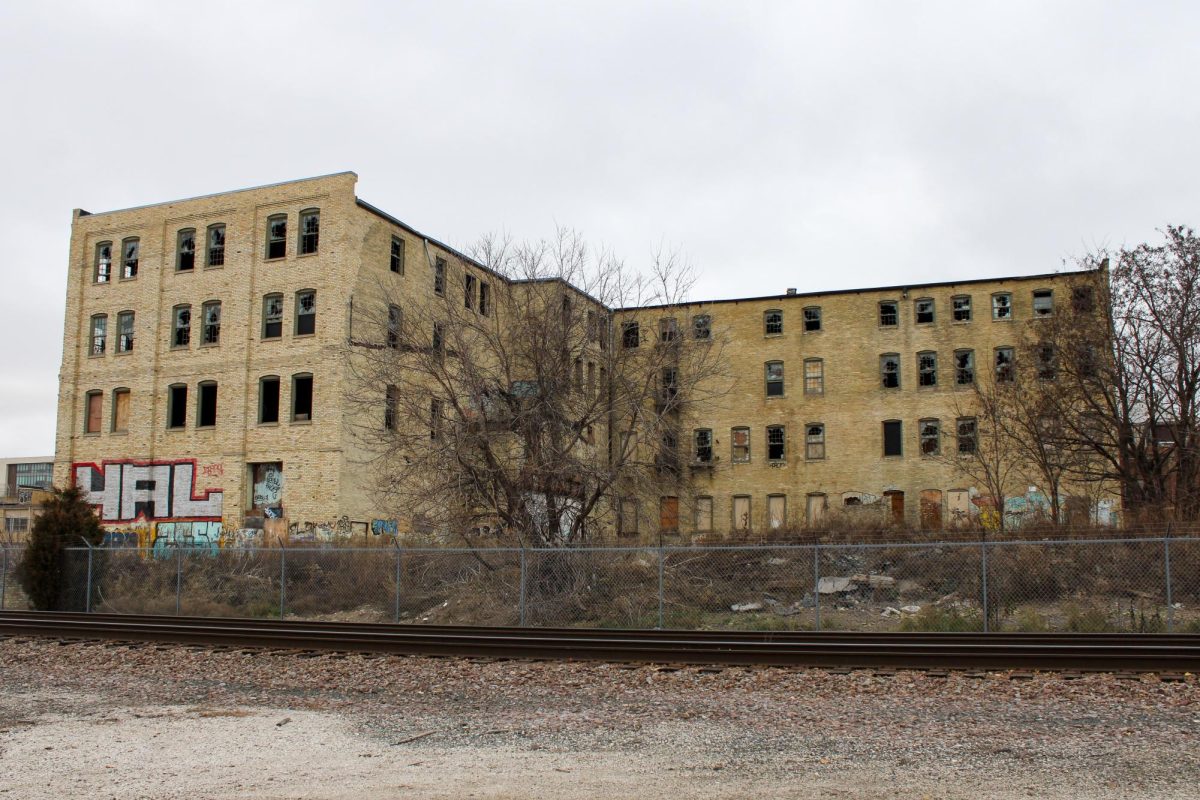This story was written in November of 2024
Just west of Milwaukee’s Third Ward sits one of the city’s most historic corridors. Parallel to a Canadian Pacific railroad and the shining Menomonee River, old buildings with new soul line St. Paul Avenue, a street sunken below the surrounding areas of the city, waiting to be discovered.
Several streets travel right above this part of the city. Each day, cars zoom across the viaducts that span the gap between the north and south sides of the city. The quiet areas below are just a blur to most commuters. Only walking down the tall, rusted metal staircases from the bridges’ sidewalks leads you into the Menomonee Valley.
At 324 N 15th St., there sits a cream brick building, with boarded up windows, graffiti covered walls, sunken floors and overgrown grass wrapping around the structure. It sits stagnantly despite an active brewery and gym next door.
Today, the avenue is a shell of what it once was, with the factories and warehouses that used to drive the city now turned into furniture stores and showrooms. Yet the future of the building on 15th Street remains unclear, with Valley business owners having different ideas for its usage. It’s one of the last remaining signs of the Valley’s late 20th century struggles.
Dave Sobelman, owner of Sobelman’s Pub and Grill, rents a two-bedroom unit located above his restaurant on the north side of the Valley. This is the only remaining residence in the Menomonee Valley. With vast unused space around the neighborhood, Sobelman said he would like to see something different.
“I’d have people living in the Valley, who are potential customers,” Sobelman said. “You’d have activity, you’d have people driving through and keeping an eye on the Valley. So having a residential property down here is a plus.”
Sobelman considers the other businesses in the Valley his neighbors. He provides flowerpots for Bay View Packing next door. Sobelman also said he delivered burgers to City Lights Brewing Co. after their food truck caught fire on multiple occasions. In the evenings, Sobelman is at his restaurant working, catching up with his patrons and sharing a laugh with the people inside. However, the rest of the Valley is a ghost town after sunset.
According to Menomonee Valley Partners, a nonprofit founded in hopes of rejuvenating this blighted part of the city, the decades of heavy industry produced high levels of asthma and obesity in the surrounding residences, and the air quality was poor. This, in combination with I-90 running through a populated area north of St. Paul Avenue, caused a mass exodus from the Valley.
Despite its former reputation, the Menomonee Valley is home to a historic charm that remains important to Milwaukee. Smith said that the organization is working to find ways to redevelop the cream brick building at the corner of 15th Street and St. Paul Avenue, without exposing residents to harmful industrial practices. Nia Smith, project manager of Menomonee Valley Partners cited the Materion Advanced Chemicals plant at 407 N 13th St. as an area of concern. It sits just across the street from the 15th Street site.
“Milwaukee zoning separates industrial and residential for a good reason,” Smith said. “We’re working with all of our stakeholders to find a path that is acceptable to everyone.”
The Valley was a hub for industrial jobs in the early 20th century. When manufacturing practices rapidly changed and blue-collar jobs became less common, companies in the neighborhood underwent a mass departure that has since then left some areas unused and abandoned.
This vision wouldn’t be too out of the ordinary, as the nearby residential neighborhoods provided most of the industry workers for the Valley in the 20th century.
“There’s a lot of vibrant neighborhoods to the north and south of the Valley,” Smith said. “That’s historically where people lived and commuted to work.”
Kendall Breunig, the developer of 324 N 15th St. has been pushing to see apartments in the building. While the building received recognition from the Historic Preservation Commission curbing its demolition for the foreseeable future, its potential still remains uncertain after push back from the Department of City Development.
“It’s a little different feel than the rest of the Valley,” said Breunig, regarding the St. Paul Avenue corridor. “So, I think some residential in there is just fine.”
If the Valley’s businesses have any say in the matter, it’s that the old buildings be restored. While MVP opposes the residential conversion of the building on 15th Street and St. Paul Avenue, Smith says they still cherish the unique look of the Valley.
“Personally, I think it’s cool when we can keep the historical aspect of the Cream City brick buildings,” Smith said.
Sobelman has an affinity for Milwaukee’s history as well. He recounted the time John Gurda, a Milwaukee historian, stopped into his restaurant. Gurda had just been hosting Milwaukee history trivia at Potawatomi Hotel and Casino. After asking a couple of questions, he told Sobelman that if he were participating that night, he would’ve won.
“This used to be a neighborhood at one time,” said Sobelman. “Before the freeway went through, my parking lot was 19th Street and there were houses and buildings like this along this side of the street.”
Jeff Gozdowiak has seen nearby buildings change drastically over 25 years as the owner of 4Seasons Skatepark located at 200 N 25th St. His doors, however, remain open. 4Seasons has become a hub for extreme sports enthusiasts, the only indoor park in the city. His ideas about the Valley’s future differ from Sobelman’s.
“I think it’d be cooler if the Valley stayed more lowkey, the people know we’re here, know we’re here, “ Gozdowiak said. “To the average person, it looks like mayhem but to us, it’s just a little bit of controlled chaos. That can’t exist just anywhere, this has always been a great location for us.”
Coming from a blue-collar family, Gozdowiak thinks there should be more work opportunities for people near the Valley.
“Everybody around the neighborhood, I grew up on the north side, they all worked either at Master Lock, A. O. Smith or Briggs,” Gozdowiak said. “They were all factory dudes, but they all owned their houses.”
Keeping history intact is one thing many Valley business owners say is non-negotiable. Gozdowiak reflected on South Kinnickinnic Avenue’s recent developments, saying it had “lost its personality”.
Even Sobelman’s had to be refurbished and renovated. It remains one of the staples of Milwaukee’s history, a former saloon for Schlitz brewery workers, standing tall despite the drastic changes to the neighborhood around it. Sobelman loves watching people stop to take in the towering facade before heading inside.
“If you own your restaurant, you own your gym, you own your brewery, you care about what space you’re taking up. And you care about your neighbors,” Gozdowiak said. “I hope, if it’s going to go any direction down here, it’s that people control the destiny of the area on their own rather than getting corporate interests into it.”
This story was written by Jack Belmont and Sofia Cortes. They can be reached at john.belmont@marquette.edu and sofia.cortes@marquette.edu.






